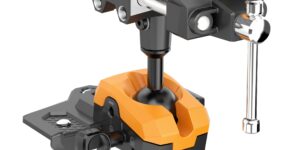SELECTING THE RIGHT WELDING HELMET FOR YOU
Though it is tempting to buy the least expensive helmet you can find, not all helmets are created equal. Eric Sommers of Miller Electric explores some new advances in auto darkening lens, variable shading, multiple sensors, viewing size, lighter weight and other options that can help personalize a helmet that?s best for you.
Posted: November 5, 2009
While welding helmets are designed to protect you from the visible and invisible (ultraviolet and infrared) rays a welding arc emits, not all helmets are created equal. There are numerous options: passive or auto-darkening lens, fixed or variable shade, two, three or four sensors, viewing size. Taking the time to find the right helmet for your needs can increase your productivity and weld quality, as well as your comfort.
First, any helmet you choose should meet ANSI Z87.1 ? 2003 (also referred to as ANSI Z87+) standards, which ensure that helmets and lenses have passed independent testing to show they can survive high velocity impact from flying objects, provide 100 percent ultraviolet and infrared filtering regardless of shade setting and meet advertised switching speeds and darkness shades in temperatures as low as 23 deg F and high as 131 deg F. Low temperatures have been known to cause delays in LCD switching times.
PASSIVE VS. AUTO-DARKENING LENS
Welding lens shade numbers refer to the lens? ability to filter light ? all auto-darkening welding helmets meeting ANSI Z87.1 provide 100 percent protection against harmful infrared and UV rays ? and may range from a #8 shade for low-amp applications up to a #13 shade for high-amp applications (see nearby chart). Top-line helmets may include additional ranges (#3 to #8) for grinding or cutting.
A passive lens helmet uses UV- and IR-coated dark-tinted glass with a fixed shade value, usually #10. The passive helmet is worn in the up position while the electrode, gun or torch is positioned. Then with a quick nod or snap of the neck, the operator flips the helmet into position immediately before striking an arc.
While passive lens helmets have passed the test of time and provide an economical choice, they have a few shortcomings:
? For the novice welder, or someone who doesn?t weld often, it can be difficult to position the electrode while the helmet is snapped into place. This can lead to poor weld starts, which may lead to weld defects or the need for excessive grinding.
? Tack welding, or numerous short welds, can be difficult and inefficient since the welder has to repeatedly lift and lower the helmet.
? The repetitive task of flipping the helmet up and down can cause neck fatigue, and in some cases may lead to repetitive stress injuries.
? Failure of the helmet to lock into position or improper timing can lead to inadvertent arc flashes if the arc strikes before the helmet is in place.
An auto-darkening lens directly addresses these issues. In its inactive state, an auto-darkening lens usually has a #3 or #4 shade, which is relatively easy to see through. When sensors on the helmet sense an arc start, the lens darkens, in a fraction of a second (typically 1/12,000 to 1/20,000 of a second for industrial-grade helmets), to shade #8 to #13.
Because the helmet stays in position before, during, and after the weld, an auto-darkening welding helmet enables you to set up your welding joint with the hood in position. No more head snaps to lower the helmet. No more sloppy starts because the torch moved. No more raising and lowering the helmet for tack welds. This not only has the potential for improving weld quality, it can ease the neck strain associated with snapping the helmet into place.
Ed Forbes, vice president of operations for Engineered Metals & Composites, Inc. (EM&C; West Columbia, SC), said his company has never even allowed a traditional welding helmet into its plant. EM&C, a leading designer and manufacturer of aluminum components for small boats and yachts, is known for its high-volume, high productivity TIG fabrication skills.
?We knew that repetitive stress injuries can and do occur as a result of using traditional welding helmets, so we standardized all 105 of our welders on auto-darkening helmets right from the start,? Forbes said. ?Because auto-darkening helmets are all we use, we?ve been able to reduce our workers compensation insurance rates and had fewer trips to the emergency room from arc-flashed eyes than companies that use traditional helmets.?
EM&C isn?t alone in this regard. To encourage operators to use an auto-darkening helmet, companies such as Vermeer Manufacturing Company split helmet costs 50-50 with the operator, and the operator owns the helmet outright after three years. To make the helmets easy to purchase, Vermeer?s welding supply partner maintains an on-site inventory.
AUTO-DARKENING OPTIONS
Auto-darkening helmets are available for every welding level, from the hobbyist to the professional. If you?ve decided to go with an auto-darkening helmet, consider:
? Fixed or Variable Shade. When a fixed-shade auto-darkening helmet senses an arc, it darkens to a fixed #10 shade, combining the economy of a fixed shade helmet and the benefits of auto-darkening. If most of your welding involves similar material of similar thicknesses using the same welding process with a limited amperage range, then a fixed shade helmet may be the right choice for you. (See the chart below to determine the correct shade number for your welding applications.)
However, if you use different welding processes (Stick, MIG, TIG), or vary welding amperage and thus vary the brightness of the arc, a variable shade lens allows you to properly and comfortably protect your eyes while achieving the best view of the puddle. Most variable shade lenses adjust from shade #9 through #13.
? Lens reaction time indicates how quickly the lens will switch from its natural light state (usually shade #3 or #4) to the darkened shade when welding begins. The quicker a welder?s eyes are shaded from the high-intensity light, the better. Entry-level lenses are often rated at 1/3,600 of a second, while industrial or professional grade helmets can be rated as high as 1/20,000 of a second. The more arcs you start in a day, the more you?ll appreciate the quicker speed. If you spend all day welding with a lens rated at 1/3,600, the cumulative effect of the increased exposure to the arc light may lead to eye fatigue at the end of the day. With faster switching speeds, these effects are reduced.
? Viewing size is one of the major considerations in purchasing an auto-darkening helmet and is really based on personal preference as well as how much out-of-position welding you?re likely to be doing. Typical view sizes range from 6 sq in for a light duty applications to 9 sq in for industrial use.
? Number of sensors. The number of sensors ranges from two for a hobby level helmet to four for an industrial grade helmet. More sensors mean better coverage, especially for out-of-position welding where a sensor could be obstructed. Three may be sufficient for production work or when you will have a clear line of sight to your work. Four is optimal for most fabrication and out-of-position work.
? Adjustable Sensitivity Control. Both intermediate and professional level auto-darkening helmets usually provide the ability to adjust how much brightness will trigger the lens to darken. Sensitivity control is useful when welding at low amperages, especially TIG, when the arc isn?t as bright as other welding processes.
? Adjustable Delay Controls. A delay control is another useful feature. This control enables you to set how long the lens stays dark after the welding arc stops. When tack welding on a large project, a short delay helps get the job done faster as you reposition for the next weld. A longer delay time is helpful when welding at very high amperages, since molten metal may still emit harmful rays until it cools.
OTHER HELMET CONSIDERATIONS
A lighter weight helmet minimizes strain on the user?s neck reducing fatigue and increasing comfort. You will notice a big difference between a helmet that weighs one pound vs. one that weighs two pounds. While one pound might not seem like much for a few short welds, the more you weld, the more you and your neck will appreciate the difference.
Finally, the latest entries into the auto-darkening helmet field provide benefits specifically for the industrial welder: aluminum heat shield to protect the lens from high heat (300+ amps) applications, silver coloring to reflect the heat away from the wearer, gaskets for shock absorption and increased longevity and commonality of parts to decrease inventory requirements for larger organizations.
If welding is, or is part of your career, take the time to find the helmet that?s right for you. While it may be tempting to buy the least expensive helmet at the local hardware store, taking the time to explore all of your options can have long-term benefits.
– – – – – – – – – – – – – – – – – – – – – – – – – – – – – – – – – – – – – – – – –
Eric Sommers is a product specialist for Miller Electric Mfg. Co., 1635 West Spencer Street, P.O. Box 1079, Appleton, WI 54912-1079, www.millerwelds.com/products/weldinghelmets .









